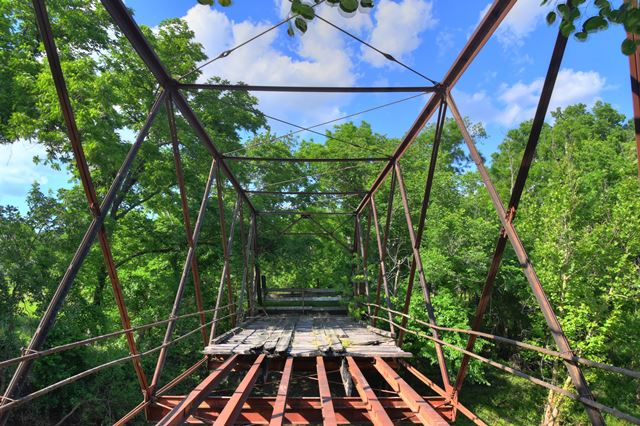We Recommend:
Bach Steel - Experts at historic truss bridge restoration.
BridgeHunter.com Phase 1 is released to the public! - Visit Now
Nebraska Road Bridge

Primary Photographer(s): Nathan Holth
Bridge Documented: June 4, 2016
Rural: Franklin County, Kansas: United States
Metal 6 Panel Multiple-Type-Connected Double-Intersection Warren Through Truss, Fixed
1895 By Builder/Contractor: Kansas City Bridge Company of Kansas City, Missouri
1909
100.0 Feet (30.5 Meters)
101.0 Feet (30.8 Meters)
15.7 Feet (4.79 Meters)
1 Main Span(s)
301047404842

View Information About HSR Ratings
Bridge Documentation
View Kansas Historic Resources Inventory Report For This Bridge
This is one of the most unusual truss bridges in Kansas, and has a high level of historic significance. It is a very unusual hybrid of riveted and pinned connections. In regards to primary truss members, the lower chord is pin-connected, but everything else in the truss web is rivet-connected. As such, the lower chord connections include a pin for the lower chord eyebars, while a gussett plate is present for the diagonal members and floor beams. The upper chord connections are all riveted, so only a gusset plate is present. However, the lateral bracing connections nearby are pin-connected, with the upper lateral bracing attaching to these pins via uncommon four-prong loops which are more commonly found in older (1880s) truss bridges.
Another unusual feature of this bridge is that it is exceedingly lightweight. Its members are remarkably simple and small in size for a bridge of these dimensions.
This bridge therefore appears to be highly significant as a rare example of a bridge documenting a company's experimentation with connection types; representing an overall transition in the bridge industry from pinned to riveted connections. This bridge, based on its lightweight design, appears to be noteworthy as an example of a lightweight "budget" bridge. Many lower-cost bridges of this lightweight caliber were likely built, but few would have been able to withstand the rigors of even the first half of 20th century traffic, meaning very few examples survive today. It stands to reason that the historic truss bridges that survive today would tend to be the best-built and heaviest-built bridges, since in most cases, only those would be able to stand the test of time and increasing loads and traffic.
There was initially some confusion as to when this bridge was constructed. The Kansas Historic Resources Inventory is very conflicting. It appears to offer well-documented evidence (1895 county commission meetings describing a contract to Kansas City Bridge Company) which would normally be solid evidence. Yet another page states that the 1909 date is "certain" from "plates at both ends of the bridge" which a field visit by HistoricBridges.org did not reveal. The documentation also describes 1909 inscriptions in concrete and mentions a 1909 raising of the bridge. HistoricBridges.org considered all the above as well as observations in the field, and came to the following conclusion. While it remains unclear what 1909 plates the documentation refers to, this may in fact be an error, and that this is in fact an 1895 bridge raised on reconstructed abutments in 1909. Stylistically, the combination of older technology like four-pronged forged eyes alongside riveted connections holding very lightweight members together seems far more like something that would have been constructed in 1895.
This bridge has been completely abandoned. Given its unique design and high significance, this bridge should be relocated and preserved, likely for non-motorized use on a trail or in a park.
![]()
Photo Galleries and Videos: Nebraska Road Bridge
Bridge Photo-Documentation
Original / Full Size PhotosA collection of overview and detail photos. This gallery offers photos in the highest available resolution and file size in a touch-friendly popup viewer.
Alternatively, Browse Without Using Viewer
![]()
Bridge Photo-Documentation
Mobile Optimized PhotosA collection of overview and detail photos. This gallery features data-friendly, fast-loading photos in a touch-friendly popup viewer.
Alternatively, Browse Without Using Viewer
![]()
Maps and Links: Nebraska Road Bridge
Coordinates (Latitude, Longitude):
Search For Additional Bridge Listings:
Bridgehunter.com: View listed bridges within 0.5 miles (0.8 kilometers) of this bridge.
Bridgehunter.com: View listed bridges within 10 miles (16 kilometers) of this bridge.
Additional Maps:
Google Streetview (If Available)
GeoHack (Additional Links and Coordinates)
Apple Maps (Via DuckDuckGo Search)
Apple Maps (Apple devices only)
Android: Open Location In Your Map or GPS App
Flickr Gallery (Find Nearby Photos)
Wikimedia Commons (Find Nearby Photos)
Directions Via Sygic For Android
Directions Via Sygic For iOS and Android Dolphin Browser
USGS National Map (United States Only)
Historical USGS Topo Maps (United States Only)
Historic Aerials (United States Only)
CalTopo Maps (United States Only)

